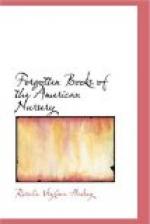FOOTNOTES:
[6-A] Records of Mass. Bay, vol. i, p. 37 h.
[6-B] Ibid., vol. i, p. 37 e.
[6-C] Ford, The New England Primer, p. 83.
[6-D] Records of Mass. Bay, vol. i, p. 328.
[7-A] Ford, The New England Primer, p. 92.
[7-B] Ibid.
[11-A] In the possession of the British Museum.
[14-A] Ford, The New England Primer, p. 38.
[14-B] Ibid.
[19-A] Thomas, History of Printing in America, vol. iii, p. 145.
[19-B] Ibid., vol. i, p. 294.
[26-A] Sears, American Literature, p. 86.
[26-B] Although this appears to be the first advertisement of gilt horn-books in Philadelphia papers, an inventory of the estate of Michael Perry, a Boston bookseller, made in seventeen hundred, includes sixteen dozen gilt horn-books.
CHAPTER II
1747-1767
He who learns his letters fair,
Shall have a coach and take the air.
Royal Primer, Newbery, 1762
Our king the good
No man of blood.
The New England Primer, 1762
CHAPTER II
1747-1767
The Play-Book in England
The vast horde of story-books so constantly poured into modern nurseries makes it difficult to realize that the library of the early colonial child consisted of such books as have been already described. The juvenile books to-day are multiform. The quantities displayed upon shop-counters or ranged upon play-room shelves include a variety of subjects bewildering to all but those whose business necessitates a knowledge of this kind of literature. For the little child there is no lack of gayly colored pictures and short tales in large print; for the older boys and girls there lies a generous choice, ranging from Bunny stories to Jungle Books, or they
“May see how all things are,
Seas and cities near and far.
And the flying fairies’
looks
In the picture story-books.”
The contrast is indeed extreme between that scanty fare of dull sermons and “The New England Primer” given to the little people of the early eighteenth century, and this superabundance prepared with lavish care for the nation of American children.
The beginning of this complex juvenile literature is, therefore, to be regarded as a comparatively modern invention of about seventeen hundred and forty-five. From that date can be traced the slow growth of a literature written with an avowed intention of furnishing amusement as well as instruction; and in the toy-books published one hundred and fifty years ago are found the prototypes of the present modes of bringing fun and knowledge to the American fireside.




